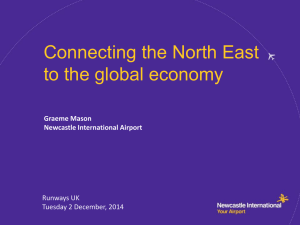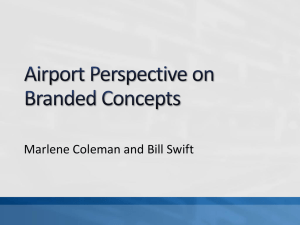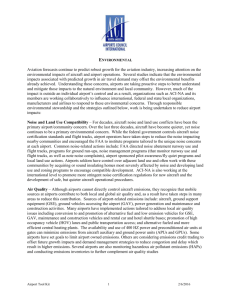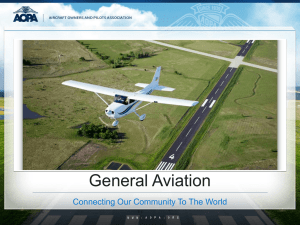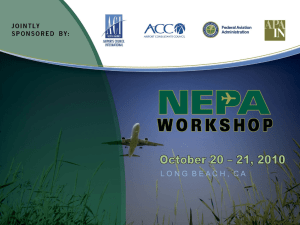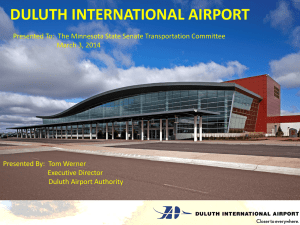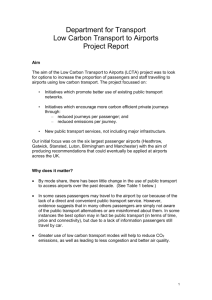City centre airports – positives
advertisement
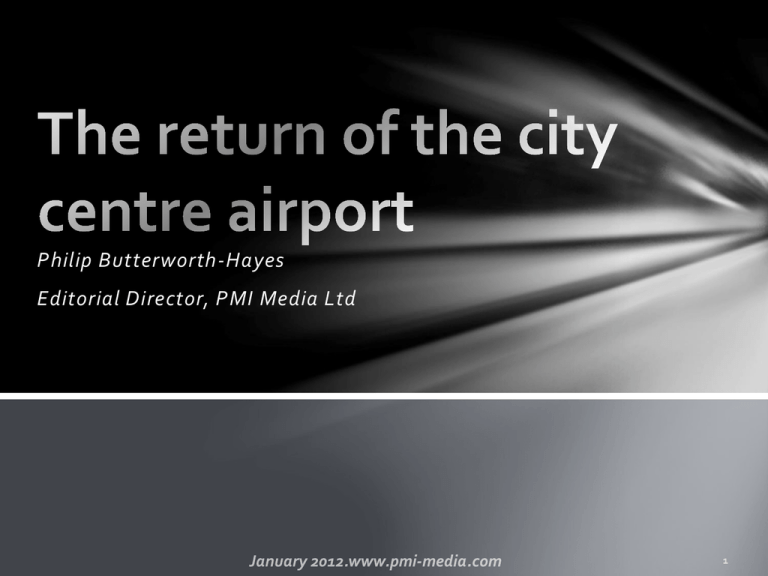
Philip Butterworth-Hayes Editorial Director, PMI Media Ltd About us PMI Media Ltd is an international aviation consultancy specialising in air transport infrastructure projects. Recent airport projects include: • Helping to compose a vision statement for ACI Europe • Airport development plans for facilities in the UK, Norway and Sweden • Working with US states and an association of air taxi operators seeking to develop software bridges between air taxi operators and potential customers at small airports • Developing a business plan for a US airport seeking to develop an air cargo ‘airport city’ complex • Helping a major UK regional airport write a ten-year business plan, including 40-year traffic forecasts • Analysing hardware buying trends among airport BOT managers • www.pmi-media.com and www.trainingandsimulationforum.net The world is changing… http://www.youtube.com/watch?v=rhpPhvWvLgk Everyone wants different types of airports The passenger wants the shortest, cheapest, most comfortable journey from origin to destination, using local facilities and a “seamless” travel mode. The aircraft operator wants the passenger to take the most expensive travel alternative offered, and to exploit this desire to travel through offering as many value-added services as possible. The airport operator wants the passenger to spend money at the airport on goods and services, to linger, but not too long. The government wants the passenger to travel via remote airports, far from urban areas , to minimise political dissent and optimise tax and wealth generating activities. Local communities want the economic benefits of living next to thriving airports but not the disruption they cause. Result? You will not be able to please everyone but, in general, the type of airport that emerges is a political, rather than a predict-and-provide, outcome. In Europe, the trend is for airline growth rates to exceed the capacity of major airports - if traffic doubles every 20 years it is unlikely the continent’s major hubs will be able to double their capacity over the same period given the environmental restrictions on runway developments. As a result: • Other continents will replace Europe as global hubs between east and west (already happening) • Demand for new services will be met increasingly by regional facilities (already happening) • Increasing political mechanisms used to balance capacity and demand (already happening) Europe is losing aviation market share 1 ATLANTA GA, US(ATL) 89 331 622 1.5 2 BEIJING, CN(PEK) 73 948 113 13.1 3 CHICAGO IL, US(ORD) 66 774 738 4.1 4 LONDON, GB(LHR) 65 884 143 ( 0.2) 5 TOKYO, JP(HND) 64 211 074 3.7 6 LOS ANGELES CA, US(LAX) 59 070 127 4.5 7 PARIS, FR(CDG) 58 167 062 0.5 8 DALLAS/FORT WORTH TX, US(DFW) 56 906 610 1.6 9 FRANKFURT, DE(FRA) 53 009 221 4.1 10 DENVER CO, US(DEN) 52 209 377 4.1 11 HONG KONG, HK(HKG) 50 348 960 10.5 12 MADRID, ES(MAD) 49 844 596 3.0 13 DUBAI, AE(DXB) 47 180 628 15.4 14 NEW YORK NY, US(JFK) 46 514 154 1.4 15 AMSTERDAM, NL(AMS) 45 211 749 3.8 16 JAKARTA, ID(CGK) 44 355 998 19.4 17 BANGKOK, TH(BKK) 42 784 967 5.6 18 SINGAPORE, SG(SIN) 42 038 777 13.0 19 GUANGZHOU, CN(CAN) 40 975 673 10.6 20 SHANGHAI, CN(PVG) 40 578 621 26.4 Aviation will find new ways to reintegrate with society Technical trends – advances in smaller aircraft designs. Longer ranges off short runways, more aircraft off single-runway airports (LGW around 250,000 movements off a single runway), quieter aircraft, personal aircraft. VLJs and A380s. Sociological trends – megacities , swallowing up smaller towns, making remote airports city-centre airports. Globalisation developing so air travel is normal, not special. Internet giving power to the passenger – increasingly able to trade cost with comfort, schedule and convenience. Aircraft operators must offer more choice. Political trends – environment falls down the political agenda as economic priorities increase; capital cities v regions, de-centralisation of infrastructure decision-making Industry trends – the success of low cost models, increased affordability of air travel Fastest growing airport in the UK? ….Oxford • Growth is up 12.2% in 2011 over 2010 • In 2011 the runway strength was reassessed at a PCN of 38 and is now suitable for use by a number of heavier regional jets including the Embraer E-Jet series and the A318/319 family. • The airport is now routinely visited by larger jet types, including the Embraer EMB-190 and Avro RJ with seating capacity of 100 plus. • Oxford Airport is also prepared for the next generation of regional jets including the Sukhoi Superjet and the Bombardier C-Series, meaning 110 passengers will be able to fly more than 2,670 nm out of Oxford – covering destinations as far as Sharm El Sheikh in Egypt. • The larger 135-seat CS300 will be able to cover most of Europe from Oxford. The new runway length enables longer range private jets such as the Global and G550 family to undertake transatlantic flights on a commercial basis. Around the world city centre airports are booming London City Planning for a 2012 Olympic boom. London City Airport (LCY) saw more than three million passengers pass through its gates in 2011,a 7.6% increase over 2010. The airport is looking forward to building on this further in the coming 12 months, increasing leisure and business traveller passenger numbers, as well as growing the dominant inbound market from European business hubs and New York City. Belfast City Extending into Europe. In October 2011 the airport launched its first direct services into the European continent with a flight to Amsterdam, the first of seven new European routes operated by bmibaby, with Geneva beginning in December 2011 and Malaga, Faro, Alicante, Palma, Ibiza starting in 2012. Just completed a private investment of £15 million into a new terminal. Stockholm Bromma – we will hear elsewhere today of progress Especially in north America Billy Bishop Toronto City Airport Passengers up 37 per cent. Expected to surpass its estimate of 1.5 million passengers for 2011, an increase of 37 per cent over 2010, and double the number of passengers it served in 2009. Washington Reagan Passengers up from 12,800, 858 in 2009 to 14,499,823 in 2010 – or 13.2%. Chicago Midway Midway has recently been named "fastest-growing" airport in the U.S. by anna.aero. Indeed, Midway is one of the fastest-growing airports in the U.S. with steady growth in passenger traffic. Through October 2011, passenger activity was up 6.7 per cent from the same period a year ago. As new ways are being found to balance economic growth with environmental concerns St Paul Downtown Planning major growth. The airport is forecasting operations will increase from 111,870 in 2010 to 137,310 in 2025 with the number of aircraft based there rising from 105 to 128. San Diego International Airport San Diego International Airport's expansion program, dubbed "The Green Build", is expected to help the airport meet current and future travel demands. Expected to be complete in early 2013, the project focuses on expansion and enhancements at Terminal 2. Traffic in 2011 will be around 1% lower than in 2010 – but international passenger numbers are over 63%. The traditional view… City centre airports - negatives • Unpopular with local residents - noise and air quality • Limited room for expansion and commercial opportunities • Limited connectivity (motorways, high-speed rail) • Limited aircraft types and range of destinations • Few hub and spoke opportunities for airlines City centre airports – positives • Popular with passengers for easy access • Valuable land assets • Very fast journey from arrivals hall to aircraft • Linked to the community Remote hubs – negatives Expensive to plan, build and operate Far from city centres Not generally popular with LCCs Not linked to local communities, more of a global player Remote hubs - positives Multiple opportunities to develop airport city businesses – MRO, logistics etc Multiple opportunities for growth, expansion, hub and spoke operations Multi-modal link opportunities Lower noise footprint over populated areas The big change… Power to the passenger The internet is slowly passing power from the infrastructure providers and aircraft operators to the individual passengers who will increasingly be able to trade between price, convenience, comfort. http://www.flyvictor.com/ “Victor allows members to book spare seats on private flights already chartered by jet owners, meaning owners can cut down on the cost of flying. To date the web-based business has been funded by Mr Jackson, who came up with the idea when his regular Palma de Mallorca to London Heathrow flight was discontinued by BMI.” With such software tools passengers are slowly creating their own air travel system, in the same way digital television/internet subscribers are creating their own viewing media. The consequence Full fare airlines will continue to grow/consolidate activities Hubs will continue to develop in remote locations BUT As the twenty-first century becomes more urban in its thinking: • New city centres will emerge which will re-integrate urban societies with local businesses • There will be a rebalance of the environment V economy debate as issues are better understood • Transport choice power will become increasingly democratic – people will make their airline operations.

